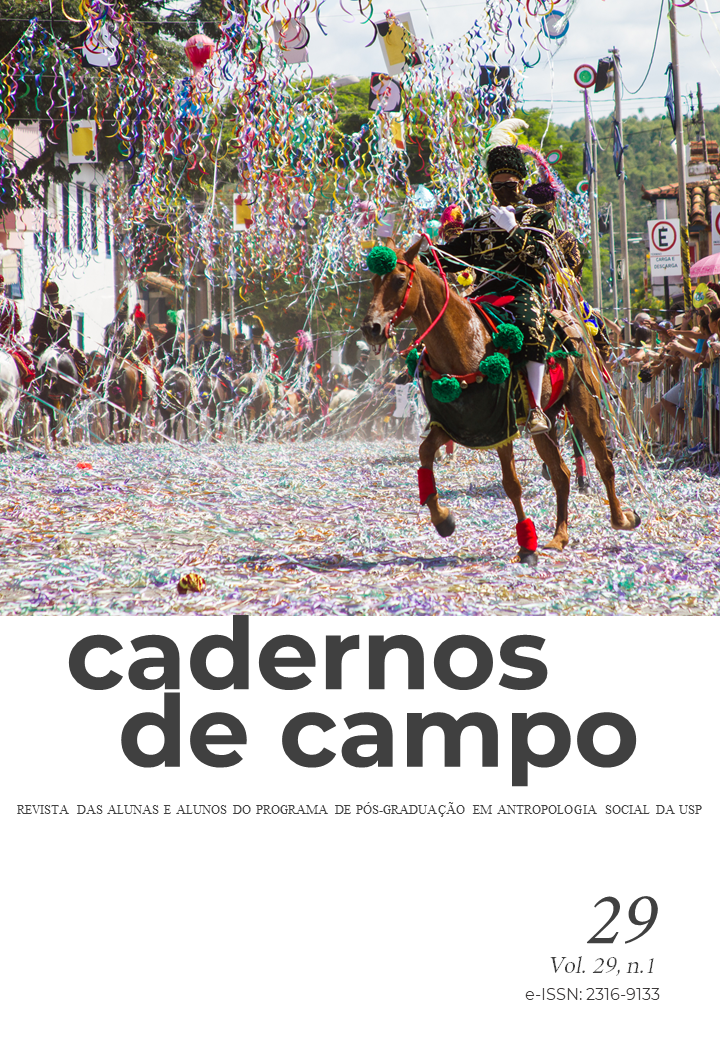Chronicles of life and death
what and how I learned (of) what my Tukano friends taught me
DOI:
https://doi.org/10.11606/issn.2316-9133.v29i1p225-246Keywords:
life, death, knowledge, Eastern Tukano, Indigenous WomenAbstract
In this chronicle, I look back to fragments of experiences lived over fifteen years of work, research and friendship between/with Tukano, Desana, Yeba, Tuyuka, Siriana, Bará and Tariano residents of the middle and upper stretches of the Tiquié River, a tributary of the Uaupés River. It is located in the Indigenous territory of Alto Rio Negro, Northwest Amazon. In a free, non-linear and perhaps indirect way, I seek to present part of what I learned and how I learned the knowledge that these women showed me about life and death.
Downloads
References
BELAUNDE, Luisa Elvira. (2001). Viviendo Bien: género y fertilidad entre los Airo-Pai de la Amazonia Peruana. 1° ed. Lima: CAAAP,
CABALZAR, Aloizio. (2008). Filhos da Cobra de Pedra: Organização social e trajetórias tuyuka no rio Tiquié (noroeste amazônico). São Paulo/Rio de Janeiro: Editora Unesp/ISA.
CABALZAR, Flora Freire Dias. (2010). Até Manaus, até Bogotá: os Tuyuka vestem seus nomes como ornamentos. Doutorado em Antropologia Social. São Paulo: PPGAS/USP, 2010.
CHERNELLA, Janet. (2003). “Language, ideology and women's speech: talking community in the Northwest Amazon”. American Anthropologist, vol.4, p.794-806.
HUGH-JONES, Christine. (1979). From the Milk River: spatial and temporal processes in the Northwest Amazonia. Cambridge: Cambridge University Press.
HUGH-JONES, Stephen. (1995). “Inside-out and back-to-front: the androgynous housein Northwest Amazonia”. In: CARSTEN, Janet; HUGH-JONES, Stephen. About the house: Lévi-Strauss and beyond. Cambridge: Cambridge University Press.
Hugh-Jones, Stephen. (2009). The fabricated body: objects and ancestors in NW Amazonia. In: SANTOS GRANERO, F. (ed.). The Occult Life of Things. Tucson: University of Arizona Press.
MAHECHA, Dany. (2004). La formación de Masa Goro “personas verdaderas”. Pautas de crianza entre los Macuna del Bajo Apaporis. Leticia: Universidad Nacional de Colombia.
OLIVEIRA, Melissa. (2016). Sobre casas, pessoas e conhecimentos: uma etnografia entre os Tukano Hausirõ e Ñahuri porã, do médio rio Tiquié, Alto rio Negro. Tese de Doutorado em Antropologia Social. São Paulo: PPGAS-UFSC.
PEREIRA, Rosilene Fonseca. (2013). Criando gente no Alto Rio Negro: um olhar Waíkhana. Dissertação de mestrado em Antropologia. Manaus: Programa de Pós-Graduação em Antropologia Social/UFAM.
PIEDADE, Acácio Tadeu de C. (1997). Música Yepâ Masa: por uma antropologia da música no Alto Rio Negro. Dissertação de Mestrado em Antropologia Social. Florianópolis: Universidade Federal de Santa Catarina
Downloads
Published
Issue
Section
License
I authorize Cadernos de Campo Journal of Anthropology to publish the work of my authorship/responsibility, as well as I take responsibility for the use of images, if accepted for publication.
I agree with this statement as an absolute expression of truth. On my behalf and on behalf of eventual co-authors I also take full responsibility for the material presented.
I attest to the unpublished nature of the work submitted





